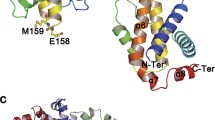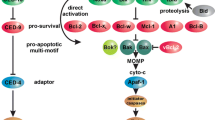Abstract
THE Bcl-2 family of proteins regulate programmed cell death by an unknown mechanism1. Here we describe the crystal and solution structures of a Bcl-2 family member, Bcl-xL (ref. 2). The structures consist of two central, primarily hydrophobic α-helices, which are surrounded by amphipathic helices. A 60-residue loop connecting helices αl and α2 was found to be flexible and non-essential for anti-apoptotic activity. The three functionally important Bcl-2 homology regions (BH1, BH2 and BH3)3–5 are in close spatial proximity and form an elongated hydrophobic cleft that may represent the binding site for other Bcl-2 family members. The arrangement of the α-helices in Bcl-xL is reminiscent of the membrane translocation domain of bacterial toxins, in particular diphtheria toxin and the colicins6. The structural similarity may provide a clue to the mechanism of action of the Bcl-2 family of proteins.
Similar content being viewed by others
References
Korsmeyer, S. J. Trends Genet. 11, 101–105 (1995).
Boise, L. H. et al. Cell 74, 597–608 (1993).
Yin, X.-M., Oltvai, Z. N. & Korsmeyer, S. J. Nature 369, 321–323 (1994).
Chittenden, T. et al. EMBO J. 14, 5589–5596 (1995).
Boyd, J. M. et al. Oncogens 11, 1921–1928 (1995).
Parker, M. W. & Pattus, F. Trends biochem. Sci. 18, 391–395 (1993).
Cheng, E. H.-Y., Levine, B., Boise, L. H., Thompson, C. B. & Hardwick, J. M. Nature 379, 554–557 (1996).
Borner, C. J. Cell Biol. 126, 1059–1068 (1994).
Hanada, M., Aime-Sempe, C., Sato, T. & Reed, J. C. J. biol. Chem. 270, 11962–11969 (1995).
Sedlak, T. W. et al. Proc. natn. Acad. of Sci. U.S.A. 92, 7834–7838 (1995).
Yang, E. et al. Cell 80, 285–291 (1995).
London, E. Biochim. biophys. Acta 1113, 25–51 (1992).
Lam, M. et al. Proc. natn. Acad. Sci. U.S.A. 91, 6569–6573 (1994).
Zamzami, et al. J. exp. Med. 182, 367–377 (1995).
Carson, M. J. J. Molec. Graph. 5, 103–106 (1987).
Fang, W., Rivard, J. J., Mueller, D. L. & Behrens, T. W. J. Immunol. 153, 4388–4398 (1994).
Otwinowski, Z. Proceedings of the CCP4 Study Weekend: Isomorphous Replacement and Anomalous Scattering (eds Wolf, W., Evans, P. R. & Leslie, A. G. W.) 80–86 (SERC Daresbury Laboratory, Warrington, UK, 1991).
CCP4: A Suite of Programs for Protein Crystallography (SERC Daresbury Laboratory, Warrington, UK, 1979).
Jones, T. A., Zou, J.-Y., Cowan, S. W. & Kjelgaard, M. Acta crystallogr. A 47, 110 (1991).
Reed, R. J. Acta crystallogr. A 42, 140–149 (1986).
Brünger, A. T. X-PLOR 3.1 (Yale University, New Haven, CT, 1992).
Yamazaki, T., Lee, W., Arrowsmith, S. H., Muhandiram, D. R. & Kay, L. E. J. Am. chem. Soc. 116, 11655–11666 (1994).
Clore, G. M. & Gronenborn, A. M. Meth. Enzym. 239, 349–363 (1994).
Logan, T. M., Olejniczak, E. T., Xu, R. X. & Fesik, S. W. FEBS Lett. 314, 413–418 (1992).
Neri, D., Szperski, T., Otting, G., Senn, H. & Wüthrich, K. Biochemistry 28, 7510–7516 (1989).
Vuister, G. W., Kim, S.-J., Wu, C. & Bax, A. J. Am. chem. Soc. 116, 9206–9210 (1994).
Kuboniwa, H., Grzesiek, S., Delaglio, F. & Bax, A. J. Biomolec. NMR 4, 871–878 (1994).
Kuszewski, J., Nilges, M. & Brünger, A. T. J. Biomolec. NMR 2, 33–56 (1992).
Farrow, N. A. et al. Biochemistry 33, 5984–6003 (1994).
Choe, S. et al. Nature 357, 216–222 (1992).
Author information
Authors and Affiliations
Rights and permissions
About this article
Cite this article
Muchmore, S., Sattler, M., Liang, H. et al. X-ray and NMR structure of human Bcl-xL, an inhibitor of programmed cell death. Nature 381, 335–341 (1996). https://doi.org/10.1038/381335a0
Received:
Accepted:
Issue Date:
DOI: https://doi.org/10.1038/381335a0
- Springer Nature Limited
This article is cited by
-
Chemical shift assignments of a fusion protein comprising the C-terminal-deleted hepatitis B virus X protein BH3-like motif peptide and Bcl-xL
Biomolecular NMR Assignments (2022)
-
Structural insight into the molecular mechanism of p53-mediated mitochondrial apoptosis
Nature Communications (2021)
-
Cryptic-site binding mechanism of medium-sized Bcl-xL inhibiting compounds elucidated by McMD-based dynamic docking simulations
Scientific Reports (2021)
-
Attenuation of inhibitory PAS domain protein-induced cell death by synthetic peptides derived from Mcl-1 transmenbrane domain
Cell Death Discovery (2021)
-
Structures of the ApoL1 and ApoL2 N-terminal domains reveal a non-classical four-helix bundle motif
Communications Biology (2021)





